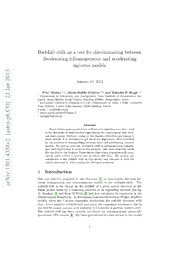
Redshift-drift as a test for discriminating between decelerating inhomogeneous and accelerating universe models PDF
Preview Redshift-drift as a test for discriminating between decelerating inhomogeneous and accelerating universe models
Redshift-drift as a test for discriminating between decelerating inhomogeneous and accelerating universe models 3 1 0 2 January 24, 2013 n a J Priti Mishra 1,a, Marie-No¨elleC´el´erier 2,b and Tejinder P. Singh 1,c 3 1 2 Department of Astronomy and Astrophysics, Tata Institute of Fundamental Re- search, Homi Bhabha Road, Colaba, Mumbai, 400005, Maharashtra, India ] 2 Laboratoire Universet TH´eories (LUTH),ObservatoiredeParis, CNRS,Universit´e O Paris-Diderot, 5 place Jules Janssen, 92190 Meudon, France C e-mail: a [email protected] b . [email protected] h c [email protected] p - o Abstract r t s ExactinhomogeneoussolutionsofEinstein’sequationshavebeenused a intheliterature tobuildmodels reproducingthecosmological datawith- [ out dark energy. However, owing to the degrees of freedom pertaining to 2 these models, it is necessary to get rid of the degeneracy often exhibited v bytheproblem of distinguishing between themand accelerating universe 8 models. Wegive an overviewof redshift drift in inhomogeneous cosmolo- 5 gies,andexplainhowitservestothispurpose. Oneclassofmodelswhich 3 fitsthedataistheSzekeresSwiss-cheeseclasswherenon-sphericallysym- 4 metric voids exhibit a typical size of about 400 Mpc. We present our . 1 calculation of the redshift drift in this model, and compare it with the 0 results obtained byother authors for alternate scenarios. 3 1 : 1 Introduction v i X One test recently proposed in the literature [1] to discriminate between dif- r ferent homogeneous and inhomogeneous models is the redhshift-drift. The a redshift-drift is the change in the redshift of a given source observed at dif- ferent proper times by a comoving observer in an expanding universe [see fig. 1]. Sandage [2] and then McVittie [3] had first calculated its expression in the Friedmannian framework. In Friedmann-Lemaˆıtre-Robertson-Walker (FLRW) models, when the Universe expansion decelerates, the redshift decreases with time, hence negative redshift-drift and when the expansion accelerates, like in the ΛCDM model, sources with redshifts .2.5 exhibit a positive redshift-drift. The redshift-drift has been recently calculated for inhomogeneous spherically symmetric LTB models [4]. We have generalized this calculation to the model 1 O′(r ,t +δt ) 0 0 0 (z +δz)(r,t+δt) O(r ,t ) 0 0 z(r,t) Figure 1: The redshift-drift δz of a source, initially at a redshift z on the past ′ lightconeofanobserveratO, as measuredbythe sameobserveratO after an elapsed time δt0 of the observer’s proper time. proposed in [5] and derived the equation for the redshift-drift in the axially symmetric QSS model [6]. 2 Redshift-drift in quasi-spherical Szekeres mod- els We derive the following equation for the redshift-drift in the axially symmetric QSS model : d δz 1 Φ¨′−Φ¨E′/E dz (cid:18)1+z(cid:19)= (1+z)2Φ˙′−Φ˙E′/Eδt0. (1) We solve eqn. (1) numerically to get the redshift-drift (z˙ = δz/δt0). In fig. 2, we display the redshift-drift for the Szekeres model, the ΛCDM model, and for three LTB models: Alnes et al.’s void model [7] and the constrained GBH (cGBH)voidmodel[8],bothstudiedin[9],andYoo’shumpmodel[10],studied in [4]. In all three LTB models the observer is located at the center of the void. The drift for all three LTB as well as for the QSS model is negative and its magnitude increases monotonically with the redshift z. The magnitude of the drift in the QSS model is higher by a factor of about two, at a given redshift, than that in the LTB models (at those redshifts where the LTB curves show a decline with increasing z). The drift in the ΛCDM model is positive up to z =2.5, while it is negative inQSSmodel. Atredshift z =3,its magnitude ismuchhigherthan thatinthe ΛCDM model by a factor of ∼14, Thus we have shown that the redshift-drift is a good discriminator between homogeneous and inhomogeneous models. 2 Redshift-drift vs. z 0.5 0 ΛCDM -0.5 LTB Voids LTB hump -1 -1yr) -1.5 100 ( -2 1 Drift* -2.5 hift- ds -3 QSS e R -3.5 -4 QSS ΛCDM -4.5 Alnes et al. LTB cGBH LTB hump -5 0 0.5 1 1.5 2 2.5 3 z Figure2: Theredshift-drift(δz/δt0)asafunctionoftheredshiftzfortheaxially symmetric QSSSwiss-cheese model [5], the ΛCDM model, the cGBH LTB void model [8] (courtesy [9]), the Alnes et al. LTB void model [7] (courtesy : [9]) and the Yoo LTB hump model [10] (courtesy : [4]) References [1] J.-P. Uzan, C. Clarkson and G. F. R. Ellis, Phys. Rev. Lett. 100 191303 (2008). [2] A. Sandage, Astrophys. J. 136 319 (1962). [3] G. McVittie, Astrophys. J. 136 334 (1962). [4] C. M. Yoo, T. Kai and K-i Nakao, Phys. Rev. D83 043527 (2011). [5] K. Bolejko and M.-N. C´el´erier, Phys. Rev. D82 103510(2010). [6] P.Mishra,M.-N.C´el´erierandT.P.Singh,Phys. Rev.D86083520(2012). [7] H. Alnes, M. Amarzguioui and Ø. Grøn, Phys.Rev. D73, 083519 (2006). [8] J. Garc´ıa-Bellido and T. Haugbølle T, J. Cosmol. Astropart. Phys. JCAP04(2008)003(2008). [9] M. Quartin and L. Amendola, Phys. Rev. D81 043522 (2010). [10] C.-M. Yoo, Prog. Theor. Phys. 124, 645 (2010). 3
